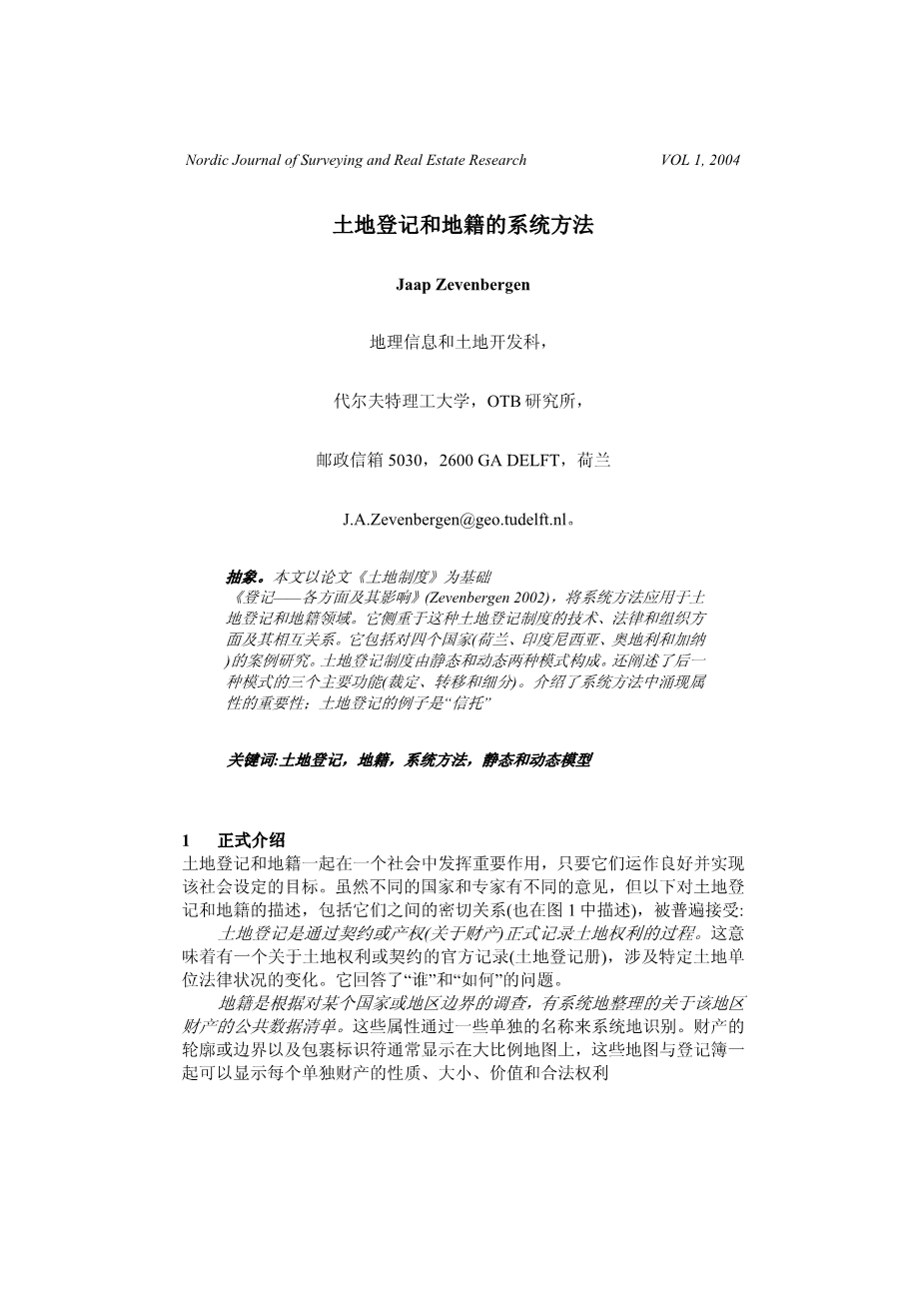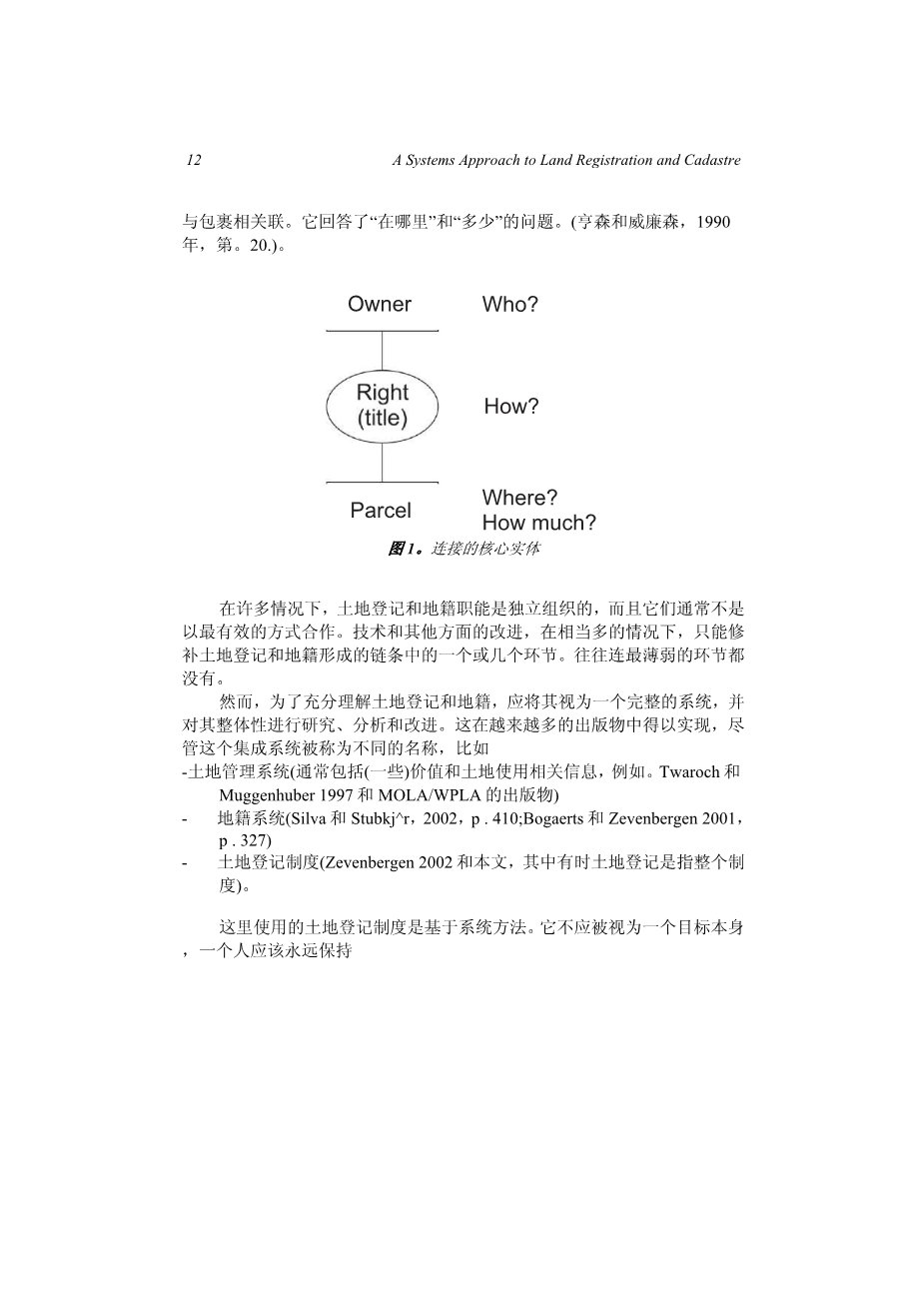A Systems Approach to Land Registration and Cadastre
Jaap Zevenbergen
Section Geo-information and Land Development,
Delft University of Technology, OTB Research Institute,
P.O. Box 5030, 2600 GA DELFT, the Netherlands
J.A.Zevenbergen@geo.tudelft.nl
Abstract. The article is based on the dissertation lsquo;Systems of Land
Registration - Aspects and their Effects (Zevenbergen 2002), which applies the systems approach to the fi eld of land registration and cadastre. It focuses on the technical, legal and organisational aspects, and their interrelation, of such systems of land registration. It includes a case study of four countries (the Netherlands, Indonesia, Austria and Ghana). The system of land registration is modelled, both by a static and by a dynamic model. The three main functions from the latter model (adjudication, transfer and subdivision) are elaborated as well. The importance of emergent properties within the systems approach is introduced; the example with regard to land registration being lsquo;trustworthiness.
Keywords: land registration, cadastre, systems approach, static and dynamic model
- Introduction
Land registration and cadastre together play an important role in a society, as long as they function well and fulfil the goals set by that society. Although different countries and experts have different opinions, the following descriptions of land registration and cadastre, including the strong relation between them (also depicted in Figure 1), are generally accepted:
Land registration is a process of official recording of rights in land through deeds or title (on properties). It means that there is an official record (the land register) of rights on land or of deeds concerning changes in the legal situation of defined units of land. It gives an answer to the question “who” and “how”.
Cadastre is a methodically arranged public inventory of data concerning properties within a certain country or district, based on a survey of their boundaries. Such properties are systematically identified by means of some separate designation. The outlines or boundaries of the property and the parcel identifier are normally shown on large scale maps which, together with registers, may show for each separate property the nature, size, value and legal rights
associated with the parcel. It gives an answer to the questions “where” and “how much”. (Henssen and Williamson 1990, p. 20.)
Owner
Who?
How?
Parcel
Where? How much?
Figure 1. Core entities connected
In many cases the land registration and cadastral functions are organised independently, and regularly they are not co-operating in the most effective way. Improvements, both technological and others, in quite some cases only mend one or a few links in the chain formed by land registration and cadastre. Often not even the weakest link.
To fully understand land registration and cadastre, however, it should be treated as an integrated system, and be studied, analysed and improved in its wholeness. This is done in more and more publications, although this integrated system is called by different names, like
- land administration system (which usually includes (some) value and land use related information as well, e.g. Twaroch and Muggenhuber 1997 and publications by MOLA/WPLA[1])
- cadastral system (Silva and Stubkj^r 2002, p. 410; Bogaerts and Zevenbergen 2001, p. 327)
- system of land registration (Zevenbergen 2002 and this article, where sometimes land registration is used when meaning the whole system).
The system of land registration, as used here, is based on the systems approach. It should never be seen as an aim in itself, and one should always keep
the goals of it in mind. Although the goals could be manifold, the focus here is on supplying legal security of land rights (to right holder and potential buyer).
In this article a short introduction is given into the systems approach and the system of land registration, including a static and a dynamic model of the system of land registration. The three main functions of the dynamic model (adjudication, transfer and subdivision) are further elaborated. Finally trustworthiness is presented as an emergent property of the system of land registration. Emergence is a term used to describe an attribute contributed to the system as a whole and not to one or more elements as such.
- Systems approach
The tendency within the field of land registration and cadastre to approach the object of study with a lot of emphasis on relative details, has led to onedimensional classifications (like deeds versus title registration or fixed versus general boundaries). To break away from this, there is a need for a framework to approach land registration as much as possible as a whole. Such a framework can be found in the lsquo;systems approach. A characteristic of the systems approach is that a system is studied with emphasis on the relations between its elements and the common goal this wholeness is aimed at. Traditionally subsystems are studied separately, with the idea to later put the parts together into the whole. According to the systems approach this is not possible and the starting point has to be with the total system. (Kast and Rosenzweig 1970, p. 115.)
There are many definitions of systems. Virtually all of them include the idea of wholeness, and the idea of (inter-)relation between components. A part of the defi
剩余内容已隐藏,支付完成后下载完整资料


英语译文共 14 页,剩余内容已隐藏,支付完成后下载完整资料
资料编号:[266378],资料为PDF文档或Word文档,PDF文档可免费转换为Word


